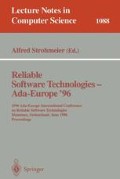Abstract
Research into persistent programming languages and systems in recent years has shown that the technology is useful for developing complex software in many problem domains. This paper explores the issues and consequences of adding persistence to Ada95. The persistence extensions support transparent migration of objects between a program's address space and a persistent store in a way that preserves both type safety and encapsulation of abstract data types.
Preview
Unable to display preview. Download preview PDF.
References
M.P. Atkinson, P.J. Bailey, K.J. Chisholm, W. P. Cockshott, and R. Morrison. An approach to persistent programming. The Computer Journal, 26(4):360–365, 1983.
M.P. Atkinson and O.P. Buneman. Types and persistence in database programming languages. ACM Computing Surveys, 19, June 1987.
M.P. Atkinson, K.J. Chisholm, and W.P. Cockshott. PS-Algol: An Algol with a persistent heap. ACM SIGPLAN Notices, 17(7):24–31, July 1981.
M.P. Atkinson, K.J. Chisholm, and W.P. Cockshott. Algorithms for a persistent heap. Software — Practice and Experience, 13(3):259–272, March 1983.
L. Cardelli. Typeful programming. Technical Report SRC Report 45, DEC Systems Research Centre, Palo Alto, 1989.
L. Cardelli and P. Wegner. On understanding types, data abstraction and polymorphism. ACM Computing Surveys, 17(4):471–523, 1985.
S.C. Crawley and M.J. Oudshoorn. Orthogonal persistence and Ada. In Proceedings TRI-Ada'94, Baltimore MD, pages 298–308. ACM, November 1994.
S.C. Crawley and M.J. Oudshoorn. Persistence extensions to Ada95. In C. Mingins, R. Duke, and B. Meyer, editors, Proceedings of TOOLS PACIFIC '95, Melbourne Australia, pages 25–39. Prentice Hall, November 1995.
A. Dearle. Environments: a flexible binding mechanism to support system evolution. In Proceedings of the 22nd Hawaii International Conference on Systems Sciences, volume 2, January 1989.
J. Donahue and A. Demers. Data types are values. ACM Transactions on Programming Languages and Systems, 7:426–445, July 1985.
G. Green. Access values pointing to any type. ACM Ada Letters, 10:101–109, May–June 1990.
ISO. Ada95 Reference Manual International Standard ANSI/ISO/IEC-8652:1995, 1995.
T. Millan and F. Mulatero. Ada persistence through an OODBMS O2. Ada User Journal, 16:71–82, June 1995.
R. Morrison, A. Brown, R.C.H. Connor, and A. Dearle. The Napier88 reference manual. Technical Report PPRR-77-89, University of St Andrews, 1989.
J. Richardson, M. Carey, and D. Schuh. The design of the E programming language. ACM Transactions on Programming Languages and Systems, 15(3):494–534, July 1993.
M.T. Rowley. An OMDG Ada95 binding. Technical report, Intermetrics Inc, September 1995. http://www.inmet.com/pob.html.
S.M. Sutton, D. Heimbigner, and L.J. Osterweil. Language constructs for managing change in process-centered environments. ACM SIGSOFT Software Engineering Notes, 15:206–217, December 1990.
U.S. Department of Defense. The Programming Language Ada Reference Manual, ANSI/MIL-STD-1815A-1983. united States Department of Defense, Washington, D.C., 1983.
U.S. Department of Defense. Ada Board's Recommended Ada 9X Strategy. Office of the Under Secretary for Defence Applications, Washington, D.C., 1988.
U.S. Department of Defense. Ada 9X Requirements, Office of the Under Secretary for Defence Applications, Washington, D.C., December 1990.
B. Walsh, P. Taylor, C. McHugh, M. Riveill, V. Cahill, and R. Balter. The Comandos supported programming languages. Technical Report TCD-CS-93-34, Trinity College, Dublin; Unite mixte BULL-IMAG, Trinity College Dublin, January 1993.
J.C. Wilden, A.L. Wolfe, C.D. Fisher, and P.L. Tarr. PGRAPHITE: An experiment in persistent object management. ACM SIGSOFT Software Engineering News, 13:130–142, November 1988.
Author information
Authors and Affiliations
Editor information
Rights and permissions
Copyright information
© 1996 Springer-Verlag Berlin Heidelberg
About this paper
Cite this paper
Oudshoorn, M.J., Crawley, S.C. (1996). Beyond Ada95: The addition of persistence and its consequences. In: Strohmeier, A. (eds) Reliable Software Technologies — Ada-Europe '96. Ada-Europe 1996. Lecture Notes in Computer Science, vol 1088. Springer, Berlin, Heidelberg. https://doi.org/10.1007/BFb0013501
Download citation
DOI: https://doi.org/10.1007/BFb0013501
Published:
Publisher Name: Springer, Berlin, Heidelberg
Print ISBN: 978-3-540-61317-6
Online ISBN: 978-3-540-68457-2
eBook Packages: Springer Book Archive

